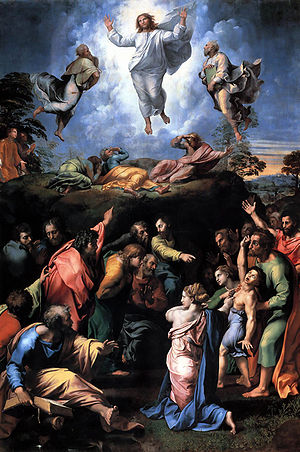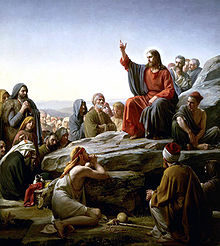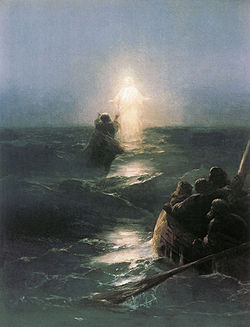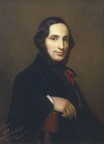







The four canonical gospels, Matthew, Mark, Luke, and John, are the main sources for the biography of Jesus' life. Three of the four Gospels, Matthew, Mark, and Luke, are known as the synoptic Gospels because they display a high degree of similarity in content, narrative arrangement, language, sentence and paragraph structures. These Gospels are also considered to share the same point of view. The fourth canonical Gospel, John, differs greatly from these three, as do the Apocryphal gospels (missing books of the bible).
Our first painting (from left to right) Christ Baptized by John the Baptist cir 1723, by Italian painter Francesco Trevisani depicts John's baptism which was a purification rite for repentant sinners, performed in "living water" (the Jordan river) in accord with Jewish custom. John, thought of as the last prophet, anticipated a messianic figure who would be greater than himself and Jesus was among those whom John baptized. Many Christian theologians believe that the ministry of Jesus followed John's, and some of Jesus' early followers had previously been followers of John. Both John and Jesus preached at times of great political, social, and religious conflict. John was the son of Zachariah, an old man, and his wife Elizabeth, who was sterile but blessed by God with late pregnancy.The angel Gabriel appeared to John's father Zachariah and announced that a son who would "be great before the Lord" would be born to Elizabeth. In Elizabeth's sixth month of pregnancy, The angel Gabriel also appeared to Jesus' mother Mary and announced that she would become pregnant with a Son "called the Son of God." Mary then traveled to a Judean town (tradition places this town as, Ein Karem, just west of Jerusalem) to visit her relative Elizabeth. When Mary entered the house of Zechariah, and greeted Elizabeth, the baby leaped in Elizabeth's womb. And Elizabeth was filled with the Holy Spirit and exclaimed with a loud cry, "Blessed are you among women, and blessed is the fruit of your womb" (Luke 1:41-42). In Christianity, John is thought of as the last prophet and Jesus as the Messiah. The problem that Jesus, considered by Christians to be without sin, received John's baptism, which was for the repentance of sins (Mark 1:4), is addressed in the Gospel of Matthew's account, which has John refusing to baptize Jesus, saying, "I need to be baptized by you," until Jesus convinces him to baptize him. Nonetheless, John does not baptize Jesus but introduces Jesus to his disciples as the "Lamb of God" (John 1:29-36. Following his baptism, Jesus was led into the desert by God where he fasted for forty days and forty nights (Mt. 4: 1-2). During this time, Satan appeared to him and tempted Jesus three times. Each time, Jesus refused temptation with a quotation of scripture from the Book of Deuteronomy. Satan departed and angels came and brought nourishment to Jesus.
The second painting,The Transfiguration by the Italian High Renaissance master Raphael was left unfinished at the time of the old master's death, and is believed to have been completed by his pupil, Giulio Romano, shortly after Raphael's death in 1520. The picture is now housed in the Pinacoteca Vaticana of the Vatican Museum in the Vatican City. The depiction is an event reported by the Synoptic Gospels in which Jesus is transfigured upon a mountain (Mount Tabor) (Matthew 17:1-9, Mark 9:2-8, Luke 9:28-36. Jesus became radiant, spoke with Moses and Elijah, and was called "Son" by God. It is one of the miracles of Jesus in the Gospels. This miracle is unique among others that appear in the Gospels, in that the miracle happens to Jesus himself. Thomas Aquinas (1225 – 7 March 1274) an Italian priest of the Roman Catholic Church in the Dominican Order, and an immensely influential philosopher and theologian in the tradition of scholasticism) considered the Transfiguration "the greatest miracle" in that it complemented baptism and showed the perfection of life in Heaven. According to the Gospels, Peter, James, son of Zebedee and John the Apostle were with Jesus upon the mountain. The transfiguration put Jesus above Moses and Elijah, the two preeminent figures of Judaism. It also supports his identity as the Son of God. In keeping with the Messianic secret, Jesus tells the witnesses not to tell others what they saw until he has risen on the third day after his death on the cross.
The third painting, Sermon on the Mount, by Carl Heinrich Bloch (May 23, 1834 – February 22, 1890) a Danish painter, according to the Canonical Gospels, the ministry of Jesus began when Jesus was around 30 years old, and lasted a period of 1–3 years. In the biblical narrative, Jesus' method of teaching involved parables, metaphor, allegory, sayings, proverbs, and a small number of direct sermons. Matthew identifies Jesus as preaching the same message that John the Baptist had delivered prior to Jesus being baptised by John, namely repent, for the kingdom of heaven is near, which Matthew refers to as the good news of the kingdom—a phrase from which the term gospel derives (gospel is derived from the Old English for good news)—and then goes on to preach, teach, and heal, throughout Galilee. The healing came to the attention of people in the nearby region, and they brought their sick and ill people to Jeusus, specifically those who suffered Torment (severe pain), paralysis, seizure (referred to as epilepsy, since at that time epilepsy was a more general term than it is now), and demonic possession. In most ancient manuscripts this region is named as Syria, a Roman Province that covered a very large area. At the time, in Judaism, disease was seen as an atonement for sin, and so healing was seen as forgiveness of sin, and was usually attributed to charismatic and devout priests and other religious leaders as Jesus came to be known.
Our last painting, Walking on Water, (1888), by Ivan Aivazovsky, a painter of Armenian descent and most famous for his seascapes, which constitute more than half of his paintings. Due to his long life in art, Aivazovsky became the most prolific Armenian painter of his time. He left over 6,000 works at his death in 1900. With funds earned during his successful career as an artist he opened an art school and gallery in his home town of Feodosiya. The painting depicts Jesus performing one of many miracles. This miracle appears in the Gospels of John (John 6:16–21, of Matthew and of Mark. According to the Biblical narratives, Jesus sent the disciples in a boat, ahead of him, to Bethsaida, but when they were half way across the Sea of Galilee, Jesus walked over the lake water and met them. The narrative states that the disciples were frightened at first, thinking they were seeing a ghost, but when Jesus revealed himself and climbed into the boat, they were reassured. According to Matthew, Peter also walked out onto the water towards Jesus, but when Peter saw the wind and the waves, he became afraid and began to sink, and Jesus rescued him. During his ministry the Synoptic gospels report many miracles performed by Jesus.
Jesus also represented controversy as well. The narrative of Jesus and the Money Changers occurs in all four Gospels in the New Testament It occurs near the end of the Synoptic Gospels (at Mark 11:15–19, 11:27–33, Matthew 21:12–17, 21:23–27 and Luke 19:45–48, 20:1–8) and near the start in the Gospel of John (at John 2:12–25). As a result some biblical scholars think there may have been two such incidents. In this episode, Jesus is stated to have visited the Temple in Jerusalem, Herod's Temple, at which the courtyard is described as being filled with livestock and the tables of the money changers, who changed the standard Greek and Roman money for Jewish and Tyrian money, which were the only coinage that could be used in Temple ceremonies. Creating a whip from some cords, "he drove them all out of the temple, with the sheep and the oxen, and poured out the changers' money and overturned the tables. But he said to those who sold doves, "Get these out of here! Do not make My Father's house a house of merchandise!" It is here that the Sanhedrin fear the temperament, influence and power of Jesus and begin to plan his death.